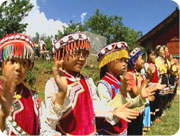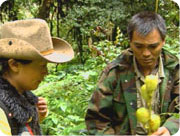In all, they ferried some 650,000 tons of supplies to China over the Hump, but at a cost: more than 600 planes and 1,000 lives were lost in the airlift.
The small chapel is located at Da Nan Mao village in Lushui County. Most of the population in the village is of Lisu, the major community in Nujiang Prefecture.

Singing is almost a way of survival for Lisu people. The history of Lisu, due to the lack of written language, was passed down in the form of singing ballads.
Without any professional training, every lisu is a good singer; but the best is when they get together in a choir and sing in harmony.
The ancestors of the Lisu once lived along the banks of Jinsha River and Yalu River. Between the 15th and 19th century, they gradually migrated into the Nu jiang area.
This church was built in 1984, but the missionaries came here in 1920s.
It was from the western missionaries that local people learned a large collection of western folk songs and holy hymns in Lisu lyrics.
Just like the hymns, Christian doctrines were also injected with local culture and thrived in its own way here.
A simple dance of hand gestures is called "Debi", also taught by the early missionaries and only to be found in Dananmao Village.
Local people told me many elderly western visitors found the dance familiar.
Xiaolan: The lyrics are, of course, about praising Jesus the Lord; and the dance, I don't know where the dance came from to tell you the truth.
Gaoligong Mountain is the natural borderline of Nujiang Prefecture and Myanmar. Because of the difficulty to reach the area, the forests and the wildlife are among the best-kept in China. The area is also listed as the UNESCO Man and the Biosphere Reserve.

The Gaoligong Mountain Nature Reserve covers an area of 124,000 hectares. The vegetation in the Reserve presents a clear vertical spectrum of six typical zones.
Interview:
Pan: If you can climb up to the top of the mountain, you'll get to see a lot of great stuff, especially precious herbal medicine. Altogether there are 16 different kinds of Hongjingtian in the country; and we've got all of them on Gaoligong Mountain.
Host: Have you seen it yourself?
Pan: Yes. I've even seen a field of almost 1,000 acres.
As if to prove that Chief Pan was not bragging at all, just minutes off the main road, we stepped into a patch of field covered with wild opium poppies.
Host: "Check this out!"
Pan: It is used to relieve inflammation.
The evergreen broad-leaved forests, deciduous forests and bamboo woodlands are characteristic of this region.
This brief expedition into just a miniscule fraction of the Gaoligong reserve already broadens ten times my knowledge base on plants and herbal medicine.
And make sure ask for Mr. Pan's number when you decide on a trip into Gaoligong mountain, without a local guide like him you will miss out on the best stuff.

